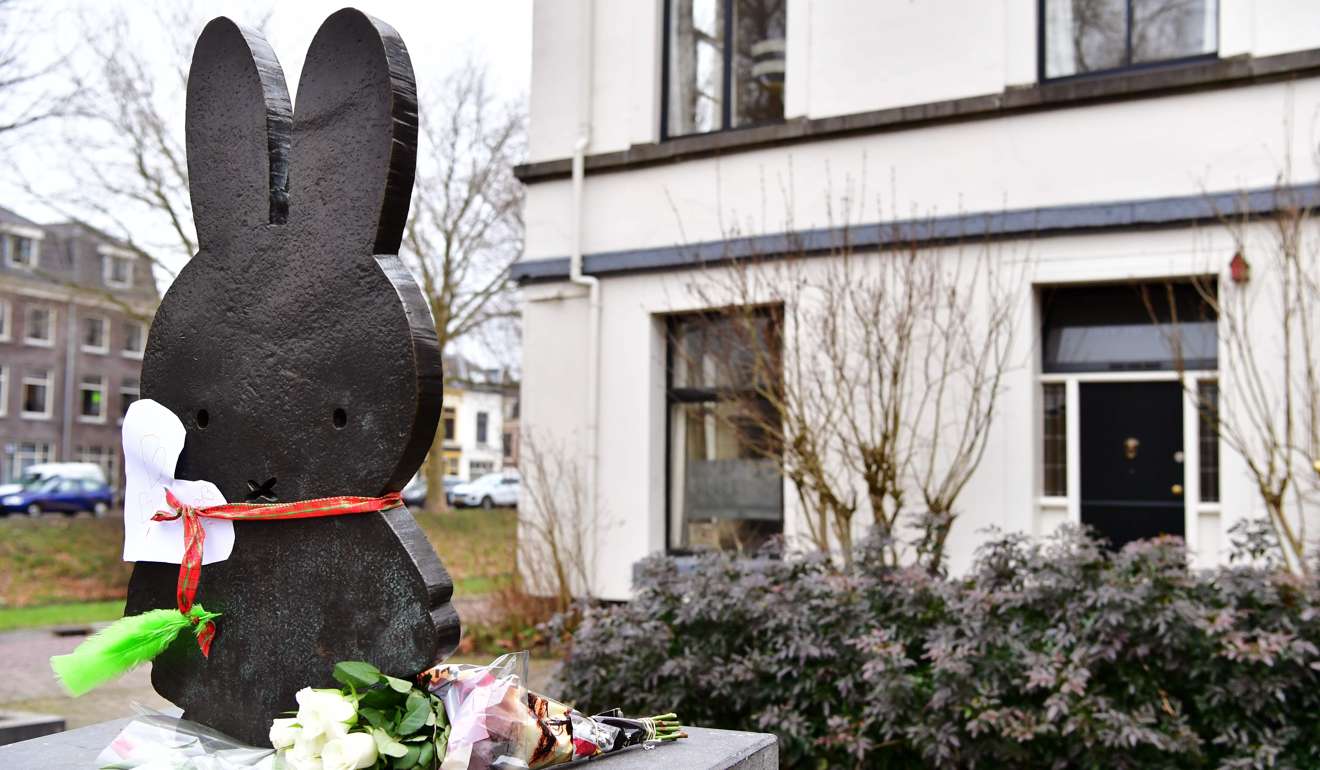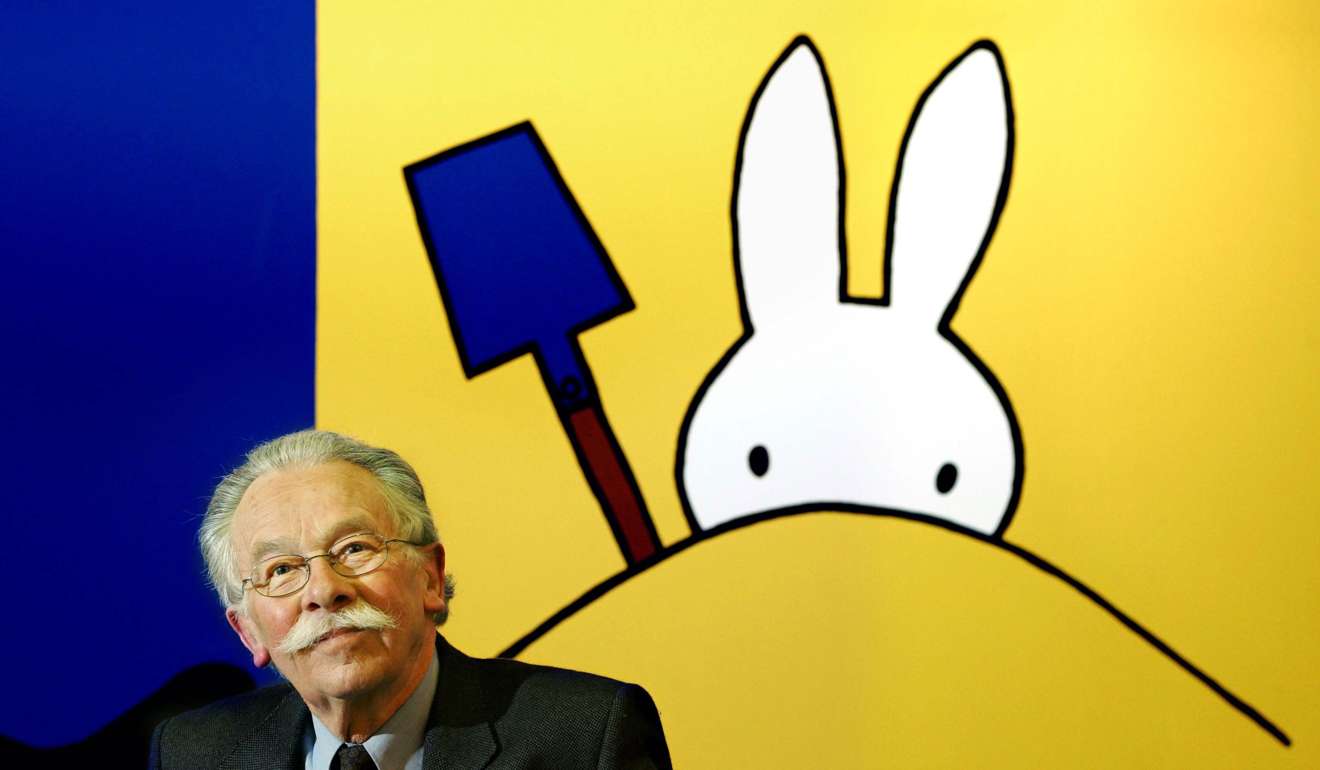
Dick Bruna, creator of rabbit Miffy, dies at 89

Dick Bruna, the prolific Dutch illustrator and author, who has died aged 89, is best known as the creator of the iconic, minimalist figure of Nijntje, known in English as Miffy.
Miffy first appeared in Dutch illustrated books for the very young, but now graces merchandise for every age group the world over, as well as greeting visitors to her home country from the walls of Schiphol airport in Amsterdam.
Appearing first in 1955, in a picture book based on a story Bruna told his young son during a holiday, after they had seen a rabbit, Miffy is a simply drawn little bunny in a dress, shown only in outline, on a white page. Her house is white with scarlet shutters. Miffy remained unchanged in the many subsequent titles, although there is sometimes a scarf or hat, or outlines filled with a solid primary colour to show a change of outfit. Initially, and until the books were translated into English, the character was just a small rabbit; the gender was not defined. The most important feature of the books, Bruna said, was that “Miffy is always Miffy and a house is always a house”.
Even Miffy’s face remains apparently constant, with black dots of eyes and a cross of a mouth, although occasionally there is an addition, such as a tear. But, by an infinitesimal tilt of her head, shutting of her eyes or the position of her head in a room or a landscape, Bruna gave Miffy a full range of responses as she did all the things familiar to preschool children, such as celebrating a birthday, going to the zoo, visiting a playground or going to the seaside.

Miffy’s life is stylised and idealised, and the jaunty tone of the rhyming couplets which map out the story that the illustrations tell so eloquently adds to the upbeat feel of the books, which are reassuring to children and adults alike. From the moment of her birth, heralded in the original Miffy title by the arrival of an angel just when the rabbit mother has thought what a nice thing it would be to cook for three, Miffy glides apparently effortlessly and gracefully through the always busy and sometimes tempestuous years of a toddler. In his stylistically cool illustrations, Bruna warm-heartedly celebrated the apparently minor but nonetheless significant milestones of the very young by cleverly fusing visual sophistication with emotional simplicity.
Describing how he worked, Bruna said: “For a book of 12 pictures I make at least a hundred.” Each was drawn with a paintbrush specially trimmed by Bruna; as he got older, and despite the success of all his books, he said it got harder and harder to get the image exactly right. Miffy’s eyes and mouth were especially problematic: “That’s all you have. With two dots and a little cross I have to make her happy, or just a little bit happy, a little bit cross or a little bit sad – and I do it over and over again. There is a moment when I think yes, now she is really sad. I must keep her like that.”
Bruna was born in Utrecht, the son of Johanna Erdbrink and Albert Bruna, and the intention was that he should join the family publishing firm, AW Bruna & Zoon. But Bruna, having been sent to Paris and London to learn about publishing and bookselling, including a brief spell working for WH Smith, opted instead to train as a graphic designer. He had been a keen artist throughout his childhood, especially during the second world war years, when his family lived in the Dutch countryside and he did not go to school, educating himself instead by studying the art of Rembrandt and Van Gogh.

He studied briefly at the art school in Amsterdam for six months before leaving to join the family firm in 1951. There he worked as a designer and illustrator, creating more than 100 posters and 2,000 book jackets, including, most famously and distinctively, the covers for Georges Simenon’s Maigret titles in the 1960s, with a black pipe superimposed on a variety of backgrounds.
Bruna’s first picture book, De Appel (The Apple), was published in Holland in 1953; in 1955 came the first two Miffy titles, Miffy and Miffy at the Zoo, and success swiftly followed. From 1963 onwards Bruna created all his books (and reissued his original Miffy titles) in what was to become their trademark small, square format. By now the father of three children, he had realised that the simpler and more direct you could make a book, the better, and that the smaller format was a more manageable size for the very young.
Miffy first appeared in English in 1964 in a UK edition and the title was published almost simultaneously across Europe and in Japan (where Miffy is Usako). Bruna’s other titles included a series of adventures about a little dog named Snuffy (Snuffie in the Dutch original), retellings of traditional tales and the I Can series of books. All of these retained Bruna’s distinctive style and palette, influenced by the work of Matisse and Picasso, which Bruna had discovered while in Paris, and by the graphic design of the De Stijl movement in Holland. His books had a European flavour, while managing to remain non-specific in terms of either time or place.
Overall, Bruna wrote and illustrated more than 120 titles and sold more than 85 million books in more than 50 languages. His images, those of Miffy in particular, have found fame and influence well beyond their origins.

Bruna won many prizes, including the Golden Brush award for Boris Bear in 1990 and the Silver Slate for Dear Grandma Bunny in 1997. Bruna was especially fond and proud of the latter, the story of the death of Miffy’s grandmother. In 2016, he was awarded the Max Velthuijs prize, an oeuvre award for children’s book illustrators presented once every three years. Queen Beatrix of the Netherlands also bestowed royal honours on Bruna. In 1983, he was made a Knight of the Order of Orange-Nassau and in 2001 a Knight Commander in the Order of the Lion of the Netherlands.
The Miffy business, based in the Netherlands, became a huge international success. In 2006, for Miffy’s 50th birthday, she and Bruna were honoured by the setting up of the Dick Bruna Huis, a permanent collection of the artist’s work, in the Centraal Museum in Utrecht; the city is also home to a square named after Miffy graced by a bronze statue of the rabbit, made by Bruna’s son Marc.
In 2016, the Dick Bruna Huis was developed into the Miffy Museum , catering specifically for children aged between two and six. Across the road, at the Centraal Museum, a true-to-life rendition of Bruna’s studio in the Jeruzalemstraat, where he worked every day for 30 years, opened in 2015.
Bruna married Irene de Jongh in 1953 and she remained his primary critic: Bruna created hundreds of sketches for each Miffy he drew and it was Irene who had the final say as to which books were good enough to go ahead. They continued to live in Utrecht, where Bruna worked every day in his studio well into his 80s. Despite his very great fame and wealth, he lived a simple and routine life entirely structured around his drawing.
He is survived by his wife, two sons, Sierk and Marc, daughter Madelon, and six grandchildren.